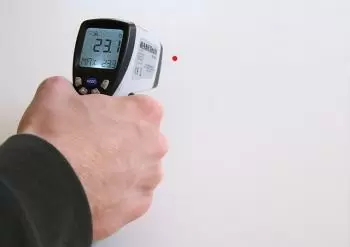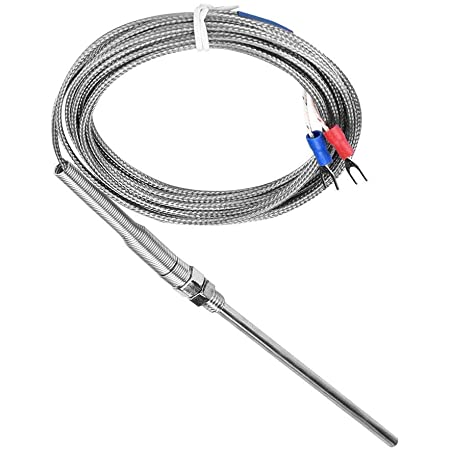
A temperature sensor is a device that generally converts a temperature value into an electrical signal that can be read. It is also often referred to as a temperature probe or thermosensor.
These devices are used in places and in devices where temperature must be accurately measured. As a result, the temperature in an integrated circuit can be monitored or regulated.
Depending on the sensor type, they can be used in solids, liquids, or gases. In addition, they can be contact and non-contact sensors.
Digital temperature sensors convert temperature measurements into digital signals, which a microcontroller or computer can easily read.
Working principle of a temperature sensor
Temperature sensors are devices that measure the temperature of a heat source. They work based on different physical principles, such as the voltage output generated by two dissimilar metals when exposed to different temperatures, the change in resistance of a metal wire when exposed to temperature changes, or the amount of infrared radiation emitted by an object.
In general, these sensors convert the temperature into an electrical signal proportional to the measured temperature. Then, this signal can then be read by a display or processed by a control system to make decisions based on these values.
Examples of temperature sensor functions
Temperature sensors have a wide range of applications in various industries and settings. Here are some examples:
-
HVAC systems: Temperature sensors are used in heating, ventilation, and air conditioning (HVAC) systems to regulate the temperature of a room or building.
-
Industrial processes: Temperature sensors are used in various industrial processes, such as manufacturing, food processing, and chemical production, to monitor and control temperature.
-
Medical devices: Temperature sensors are used in medical devices such as thermometers, incubators, and blood-warming devices.
-
Automotive industry: Temperature sensors are used in automotive applications, such as engine temperature monitoring, transmission temperature monitoring, and HVAC systems.
-
Aerospace industry: Temperature sensors are used in aircraft and spacecraft to monitor the temperature of critical components and systems.
-
Environmental monitoring: Temperature sensors are used in environmental monitoring applications, such as weather stations, to measure temperature and humidity.
-
Research and development: Temperature sensors are used to study various phenomena in research and development settings.
-
Control of a solar hot water system and the most optimal range of temperatures of a PV panel.
Overall, temperature sensing systems are essential tools for maintaining safe and efficient operations in a wide range of applications.
Types of temperature sensors
There are several types of temperatures. Some of the most common types include:
-
Thermocouples: These are temperature sensors that measure the voltage produced by two dissimilar metals when exposed to different temperatures. They are widely used in industrial and scientific applications due to their wide temperature range and durability.
-
Resistance temperature detectors (RTDs): These sensors are made of a metal wire or film that changes its resistance in response to temperature changes. They are commonly used in industrial and laboratory settings requiring high accuracy.
-
Thermistors: These are temperature sensors made of semiconductor materials that change their resistance in response to temperature changes. They are used in consumer electronics and automotive applications due to their small size and low cost.
-
Infrared (IR) sensors: These sensors detect infrared radiation emitted by objects and use it to calculate their temperature. They are commonly used in non-contact temperature measurement applications.
-
Bimetallic strip: This temperature sensor consists of two metals that expand at different rates when heated.
-
Liquid-filled temperature sensors: These sensors use the expansion and contraction of a liquid to measure temperature changes. They are used in industrial functions where the sensor must be placed in harsh conditions.
Thermocouples: working principle and uses
 Thermocouples consist of two dissimilar metal wires joined together at one end. The junction between the two metals is exposed to the temperature being measured, while the other end of the thermocouple is connected to a measuring instrument or control system.
Thermocouples consist of two dissimilar metal wires joined together at one end. The junction between the two metals is exposed to the temperature being measured, while the other end of the thermocouple is connected to a measuring instrument or control system.
The principle of operation of a thermocouple is based on the Seebeck effect, which is the generation of a voltage when two dissimilar metals are joined together and exposed to a temperature gradient. The magnitude of the voltage generated by a thermocouple is directly proportional to the temperature difference between the two ends of the wires.
Thermocouples are widely used in various industries due to their wide temperature range, high accuracy, and durability. They are used in:
-
Industrial settings include steel production, chemical processing, and furnace temperature monitoring.
-
Scientific research and development, such as thermal conductivity measurement and temperature gradient studies.
Resistance temperature detectors (RTDs): working principle and uses
Resistance temperature detectors (RTDs) use the change in electrical resistance of a metal wire or film with temperature changes to measure it. The most commonly used metals for RTDs are platinum, copper, or nickel can also be used.
The working principle of an RTD is based on the relationship between the electrical resistance of the metal and its temperature, which follows a nearly linear relationship over a wide temperature range. The RTD is connected to a Wheatstone bridge circuit, which measures the resistance of the RTD and converts it into a temperature reading.
Resistive temperature detectors (RTD) are used in industrial and scientific uses, such as in control systems, laboratories, and medical devices. They are also used in automotive uses.
Thermistors: working principles, pros and cons, and applications
Thermistors are a type of temperature sensor that uses the change in electrical resistance of a semiconductor material with temperature changes to measure temperature. The most commonly used semiconductor material for thermistors is a mixture of metal oxides, such as manganese, nickel, and cobalt.
The principle of operation of a thermistor is based on the relationship between the electrical resistance of the semiconductor material and its temperature, which follows a highly nonlinear relationship over a wide temperature range. The thermistor is connected to a measuring instrument or control system, which measures its resistance and converts it into a temperature reading.
There are two types of thermistors:
-
NTC thermistors (Negative Temperature Coefficient): the resistance decreases as temperature increases
-
PTC thermistors (Positive Temperature Coefficient): the resistance increases as temperature increases.
Infrared sensors (IR)
Infrared (IR) sensors measure the amount of infrared radiation emitted by an object to determine its temperature. IR sensors detect the heat radiated by an object in the form of infrared radiation and convert it into a temperature reading.
The principle of operation of an IR sensor is based on the fact that all objects above absolute zero emit some amount of infrared radiation, which is related to their temperature. Therefore, the IR sensor contains a detector sensitive to infrared radiation and can measure the amount of radiation emitted by an object.
An IR sensor is inherently linear and does not require linearization.
IR sensors are used in a wide range of applications, such as in food processing, medical devices, weather stations, and climate research.
Bimetalic strip
A bimetallic strip is a sensor that consists of two strips of different metals, usually brass and iron, bonded together. The metals have different coefficients of thermal expansion, meaning that they expand and contract at different rates when heated or cooled.
The principle of operation of it is based on the fact that when it is heated, one metal strip will expand more than the other, causing the strip to bend or curve. This bending or curving can be used to actuate a mechanical switch or device, such as a thermostat or circuit breaker.
Liquid-filled temperature sensors
Liquid-filled temperature sensors are a type of temperature sensor that uses a liquid, such as mercury or alcohol, to measure temperature. The liquid is contained within a glass or metal bulb and connected to a capillary tube. As the temperature changes, the liquid expands or contracts, causing a change in pressure, which is then measured and converted into a temperature reading.
The principle of operation of liquid-filled temperature sensors is based on the fact that liquids expand or contract with temperature changes. Therefore, the type of liquid used can affect the temperature range and accuracy of the sensor.